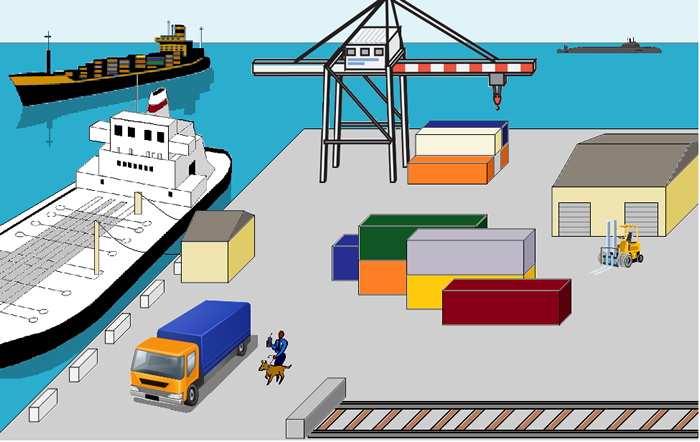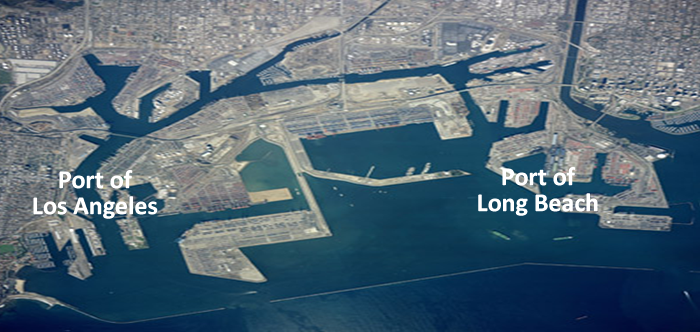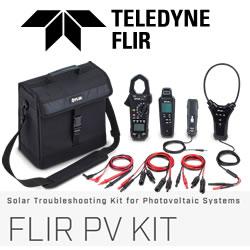Fuel cells can help resolve many issues facing ports. By deploying this clean and modern technology, ports can reduce pollution and increase operational efficiency. Fuel cells generate electricity using electro-chemical reactions, not combustion, so there are no polluting emissions, only water and heat as by-products.
The Port of the Future:
The Potential of Fuel Cells to Green Our Nation's Ports
Contributed by | Fuel Cells 2000
There are more than 100 ports in the U.S., moving goods as an essential part of the global economy. Ports have a large impact on the surrounding environment, including pollution from ocean-going ships and emissions from the yard trucks, forklifts, and container movers, as well as trucks and railcars. Cargo and cruise ships, tug boats, and yard vehicles are typically powered by diesel engines, emitting large amounts of particulate matter, nitrogen oxides, and volatile organic compounds, all of which reduce air quality and affect human health. Ports also contribute to noise and light pollution in surrounding communities.
Fuel cells can help resolve many issues facing ports. By deploying this clean and modern technology, ports can reduce pollution and increase operational efficiency. Fuel cells generate electricity using electro-chemical reactions, not combustion, so there are no polluting emissions, only water and heat as by-products. Fuel cell technologies are scalable and flexible, allowing for application throughout the port. Fuel cells can provide stationary power, motive power, and auxiliary/backup power. Fuel cells can also be used in hybrid systems, or as onboard battery chargers. Fuel cells are virtually silent, and inherently efficient.
Environmental Regulation of Port Activity
Ports have been a major source of water and air pollution in the U.S., but remained relatively unregulated until recent years. Now, as ports have begun to expand and their impact on the environment has become more apparent, port operators and personnel face a variety of regulations. The U.S. Environmental Protection Agency (EPA) and some states regulate small marine engines (Categories 1 and 2), large marine engines (Category 3), off-road diesel engines, rail engines, diesel fuel quality and more. In 2004, the EPA regulated the nitrogen oxide (NOx) emissions from large “Category 3” diesel engines,1 and four years later did the same for Category 1 and 2 engines in order to reduce these emissions by nearly 80 percent. The first phase began in 2009, with a more stringent second phase beginning in 2014.2 The EPA has also begun to limit the sulfur content allowable in marine diesel fuels, and has tightened the emission standards for non-road vehicles to compare with on-road vehicle emissions regulations.
In response to increased regulatory pressure, many ports have begun to enact sustainability goals or adopt green practices. The Port of Los Angeles has gone so far as to ratify a new lease policy with strict air, water, and noise pollution standards for tenants.3 The Port of Long Beach has developed a Clean Air Action Plan, a Green Flag Vessel Speed Reduction Incentive Program, established green leases and encourages plugging in to shore power when docked.4 The Port of Seattle has a Seaport Air Quality Program that takes a collaborative, voluntary approach. The Program looks to find emission reductions and efficiencies in moving goods.5 On the east coast, the Ports of New York and New Jersey offer grants to operators of trucks and ocean-going vessels that switch to cleaner fuels and EPA emissions-compliant engines. Similar environmental initiatives are in place at the Port of Charleston, South Carolina, and the Port of Miami, where electrification of gantry cranes is taking place on a large scale, replacing diesel engine power systems and reducing noise and emissions.
International Port Activity
These efforts are not confined to the U.S., however. Major international ports are undertaking similar projects to reduce emissions and lower the overall environmental impact of their daily operations. Regulatory pressures in the European Union and elsewhere, as well as a growing acceptance among the shipping industry for sustainable practices, are driving efforts to reduce the environmental impact of ports. Across the globe, ports are adapting to this trend. At the Gothenburg Port in Sweden, a system of rail shuttles has replaced a large number of emissions-heavy, short-distance trucks for transporting freight. Dubai’s Jebel Ali port recently announced that eight of its diesel-powered gantry cranes would be electrified, a move that will cut emissions to zero at the point of use.
Some ports have formed partnerships to more effectively pursue sustainability. The Ports of Oslo, Rotterdam, Amsterdam, Houston, and Los Angeles all participate in the World Ports Climate Initiative (WPCI), the goal of which has been to reduce greenhouse gas emissions from shipping, port operation, and port construction. WPCI has emphasized the adoption of renewable energy technologies as a means of achieving these goals. The Association of Southeast Asian Nations (ASEAN) has teamed up with the German Technical Cooperation (GTZ) to implement the "Sustainable Port Development in the ASEAN Region" project, which will help major ports in Cambodia, Indonesia, Thailand, Vietnam, and the Philippines comply with international environmental standards while also improving their efficiency.
Fuel Cells at the Port of Helsinki
Vuosaari Harbor at the Port of Helsinki, Finland is now host to an ambitious program called Demo2013, a joint effort among leading Finnish companies and research institutions that will demonstrate fuel cells in a variety of port applications aiding electricity delivery, cargo handling, communications, and logistics. Wärtsilä’s 50 kilowatt solid oxide fuel cell (SOFC) system, Hydrocell’s portable fuel cells and metal hydride storage for boats, and a hydrogen fueling station set up by Woikoski Oy will all be part of the demonstration at Vuosaari Harbor. The cumulative effect of these technology upgrades will be a dramatic reduction in emissions and a cleaner flow of commerce in and out of the Port of Helsinki.
How Fuel Cells Contribute to Sustainability at Ports
Container/Cargo Moving Vehicles
Ports handle a large volume of cargo every day, and many types of vehicles are needed to keep the flow of goods moving. Specialized cranes lift containers off and onto ships, while yard trucks, container movers, and specialized lift trucks move containers about the yards. Heavy trucks and trains carry goods out of the port and around the country. Traditionally, these vehicles all use diesel engines or generators, emitting large amounts of air pollutants and noise. Now there is a trend towards cleaner fuels and engines, as well as electrification of port vehicle fleets. These steps are vital because vehicles contribute a significant amount to a port’s overall emissions. At the Port of Los Angeles, cargo handling equipment generated almost a third of all carbon monoxide emissions, 6 percent of carbon dioxide (CO2) equivalent emissions, and nearly 10 percent of NOx emissions in 2010. Fuel cells can play an important role in cleaning up port vehicles, while helping increase cargo throughput.
Fuel cell-powered vehicles provide the same power as their diesel counterparts, but without the tailpipe emissions, smell, or noise. Like diesel engines, fuel cells can power a wide range of vehicles and equipment. Zero-emission fuel cells can help ports meet federal and local restrictions on smog causing and greenhouse gas emissions. Fuel cell-powered vehicles provide quiet operation without any headache-inducing fumes, reducing stress on drivers. Refilling time for fuel cell vehicles is similar to that of diesel, and unlike a battery system, fuel cells do not lose voltage as fuel is consumed.
Stationary Power
Container and cruise ships need to power onboard electronics while docked, but idling the diesel engines generates unnecessary emissions. In 2010 at the Port of Los Angeles, ocean-going vessels were responsible for the vast majority of total emissions. Many ports are ratifying new rules to reduce ship idling, by requiring vessels to plug into shore-based electricity. Stationary fuel cells could generate near zero-emission shore power for vessels. Fuel cells can be sited in many different locations around the port: indoors; on roofs; near buildings; giving flexibility to ports that are constrained for space.
Like fuel cells for mobile applications, stationary fuel cells come in many different sizes to support a variety of operations within a port, powering ships and buildings alike. Fuel cells can be designed to be grid independent, so if the power goes out, port operations would not be affected. This could be especially important to large ports that have automated container tracking systems, or security systems that depend upon reliable power. Providing grid independent power could attract and retain business at ports, as shipping delays cost importers money.
Auxiliary/Backup Power
Fuel cells can also be used for auxiliary power for ships and equipment, or backup power for buildings. The diesel trucks that bring goods inland can spend a significant amount of time idling in port while waiting to load or unload goods. At the Port of Los Angeles, heavy-duty trucks were responsible for approximately 43 percent of carbon dioxide equivalent emissions in 2010, and almost 20 percent of NOx emissions. An onboard fuel cell auxiliary power unit (APU) can be used to power heating and air conditioning for the cab or containers, and electronic systems such as TVs, radios, or mobile phones. Harbor boats such as tugs, pushers, and barges could use fuel cell APUs for when the vessels are close to the port, where speed restrictions are in place to reduce pollutant emissions. Container and cruise ships could use fuel cell APUs to provide power while at dock.
Port of the Future

Onboard ship power: A fuel cell system could generate prime power or could propel the ship into port at low speeds prior to docking. In addition, fuel cells could replace batteries and diesel generators used for emergency power and onboard electronics.
Shore power for cargo and cruise ships: Auxiliary diesel engines that provide power to docked ships contribute heavily to the pollution levels at ports. Stationary fuel cells could provide shore power that ships plug into. Fuel cells are quiet and there are no criteria or greenhouse emissions.
Fuel cell electric vehicles (FCEVs): Fuel cell electric vehicles can power yard tractors, heavy-duty trucks, and passenger cars used at the port facility, all while providing quiet operation and zero tailpipe emissions. Fuel cells can also be installed as an auxiliary power unit on heavy-duty trucks operating in the port that would provide power to the cab without engine idling. Using fuel cells in this way could dramatically reduce noise and air pollution at ports. One or more hydrogen stations could be deployed throughout the port to support vehicles and engines.
Security: Fuel cells can provide grid-independent power and backup power, security services that require 24/7 power, communications systems, closed-circuit video cameras, logistics centers, warehouses, buildings, guard gates, and other critical functions.
Rail transport: Fuel cells can be used as auxiliary or primary power in rail locomotives.
Fuel cell-powered forklifts: Fuel cell-powered forklifts have the same benefits of FCEVs; they are quiet and produce few emissions. Unlike battery-powered forklifts, they do not lose voltage, and they are quickly refilled. Operators will benefit by not being exposed to diesel fumes. Fuel cell forklifts can use the same hydrogen stations as FCEVs.
Refrigeration for containers: The contents of some containers need to be kept at a controlled temperature. Fuel cells can provide the necessary power, without emissions associated with diesel generators or other power sources.
Container cranes: The offloading of cargo from docked ships is typically powered by a diesel engine generator near the top of the crane or, more commonly, by electric power onshore. A fuel cell could replace or supplement either.
Military applications: The military is active at certain ports and on the seas. All branches are finding ways to use fuel cells including for submarines and boats, manned and unmanned vehicles, and stationary power.
Spotlight on the Ports of Los Angeles and Long Beach

The twin ports of Los Angeles and Long Beach, California, move more than $350 billion in goods and materials every year. Although the two ports compete for business, they collaborate on environmental programs and infrastructure projects. In particular, drayage trucks have been identified as having great potential for new technologies to help “green” their operation.
In July 2011, Vision Motor Corp., a zero-emissions vehicle manufacturer based in El Segundo, delivered a heavy-duty hauling truck to Total Transportation Services Inc., one of the port’s largest cargo haulers. The vehicle is a fuel cell-battery hybrid Tyrano Class-8 rig, capable of 200 miles between hydrogen fills thanks to the onboard fuel cell, which recharges the battery during use, eliminating the need to plug in to recharge. The truck gets the same mileage out of a kilogram of hydrogen as a gallon of diesel, but for half the price. The ports committed $425,000 from a joint Technology Assistance Program to demonstrate the Tyrano Class-8 rig, and its trial will last 18 months. Total Transportation Services has signed a letter of intent to purchase 100 heavy duty trucks from Vision upon successful demonstration, with the option to purchase an additional 300.
The Port of Los Angeles has also awarded Vision Motors up to $1.4 million to retrofit more than a dozen of the Port’s electric short-haul drayage terminal tractors with hydrogen fuel cells. The fuel cells will extend driving range, while improving operational efficiency.
Port of Long Beach
- Second largest port in the U.S.
- 3,200 acres
- No taxpayer assistance
- 10 piers, 80 berths
- 66 post-Panamax gantry cranes
Port of Los Angeles
- Largest port in the U.S.
- 7,500 acres
- No taxpayer assistance
- 25 passenger and cargo terminals, 270 berths
- 75 container cranes
“We have made great strides in reducing emissions, but we need to go further and we have to find new technologies to get us there. Clean diesel does not get us there.” - Kevin Maggay, Air Quality Supervisor, Port of Los Angeles
- “Port of Los Angeles Inventory of Air Emissions –2010.” Starcrest Consulting Group, LLC. Technical Report ADP#050520-525 July 2011.
- Ibid.
- http://www.portoflosangeles.org/Publications/POLA_Leasing_Policy_020106.pdf
- “Sustainability and Environmental Stewardship.” Douglas J. Serno, Deputy Chief Harbor Engineer Program Management, Port of Long Beach. American Association of Port Authorities, Ft. Lauderdale, Florida. January 10, 2007
- “Port of Seattle: Where a Sustainable World is Heading.” Sarah Flagg, Seaport Air Quality Program Manager. AAPA Port Operations, Safety, and Information Technology Seminar, June 11, 2009.
The content & opinions in this article are the author’s and do not necessarily represent the views of AltEnergyMag
Comments (0)
This post does not have any comments. Be the first to leave a comment below.
Featured Product

